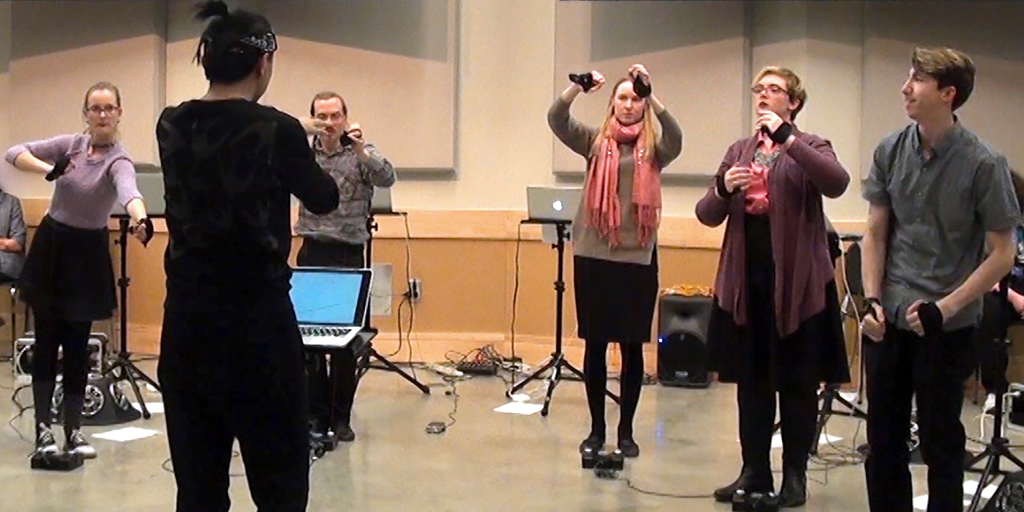Please note: We have not offered this course for years. We are hoping for a resurgence. Stay tuned.
Most live electronic music today is performed by one or two people — think of deadmau5 or Daft Punk. But what happens if you have more people playing together? In the last decade, a new form of electronic music-making has emerged: the laptop orchestra, in which multiple laptop computer musicians perform together.
The terms laptop orchestra (often abbreviated “lork”) and laptop ensemble are synonymous. Groups range in size from four to over 30.

Laptop orchestras are sprouting up all over: PLOrk, SLOrk, BLOrk, L2Ork, KLOrk, Dublork, GTLork, FLEA, FLO, HELO, LOLs, Sideband, Toneburst, and many others.
But what does a lork actually look and sound like? Check out these videos.
Five people playing various controllers, influenced by electronic dance music:
Kopenhagen Laptop Orchestra (KLO), Denmark
A larger group improvising together without a conductor:
Huddersfield Experimental Laptop Orchestra (HELO), England
A sextet performing a composition using tether controllers:
Sideband performing Jascha Narveson’s In Line
Lork performers manipulating their recorded voices by tilting laptops:
Princeton Laptop Orchestra (PLOrk) performing Perry Cook’s LOrX Aeterna
Another tether controller performance, guided by a conductor:
Stanford Laptop Orchestra (SLOrk) performing Ge Wang’s Twilight
Lork performance can work like a traditional orchestra, with a conductor directing the musicians. Or, it can be less hierarchical, featuring collective improvisation. Lorks can even use peer-to-peer wireless networking to develop a new form of musical collaboration. For example, one player could transmit her notes to another, who could respond before passing the notes on to someone else. Some people have made lork music derived from multi-player gaming scenarios.
This course is for anyone who wants to learn how to engage in this kind of cooperative electronic music-making. Performers, composers, improvisors, DJs, programmers, creative media artists — all of you can play a role, or multiple roles, within an ensemble.
It is helpful to have had some experience making electronic music, but that is not essential. You should have some kind of music background: playing clarinet in the orchestra, playing guitar in your band, singing in a choir, making beats on your computer, etc.
A laptop performer does not need strong traditional musical skills, such as sight-reading music notation or playing an instrument well. But she must be able to listen to the sound around her, make contributions at the right times, and follow simple instructions that coordinate the participants. The music is usually based on structured improvisation and does not use precisely notated musical scores.
Here are some of the things you will do as part of the course.
- Learn how existing laptop orchestras function technically and musically.
- Design a simple computer music instrument using a graphical programming language, and make a composition that the ensemble performs by playing your instrument.
- Learn how to control sound using the microphone, camera, keyboard, and trackpad of the computer.
- Attach other hardware — such as the tether controllers shown above, or gamepads, or grid controllers (like the Launchpad) — and figure out ways to control sound with them.
- Practice the pieces we create, as well as some of the ones that people outside of IU have already made.
- Put on at least one public performance.
Most of the popular commercial software tools for making music do not work well for lorks. So we have to put together our own programs. Some people like programming, others don’t. Everybody will learn at least a little music programming. After that, you can get into it as deeply as you want. I’ll help you. The programming for this ensemble will be done primarily in Max and Javascript (hosted in Max). Other music programming languages that work well for lorks include Pd, ChucK, and SuperCollider. You do not need any prior experience in programming.
If you don’t like the programming part, you can focus on making the music work well and improving the experience for the audience. Choreograph moves with the tether controller, think of new ways to conduct the ensemble, figure out a cool way to get the audience involved — maybe using their phones.
This will be a project-oriented class — like a seminar, but with a lot of hands-on sound-making activity. There will be a bit of weekly gear hauling required, in order to make all this happen.
There will be a few pass-fail assignments, but your grade is based almost entirely on attendance and being a good ensemble citizen. It’s really important that you participate in rehearsals, so that we can perform well.
NOTE: You will need a laptop to take this course! A Mac with a recent OS is preferable, but Windows laptops will work for most of the things we do.
Registration for this course is by permission of the instructor. Please write to Prof. John Gibson at johgibso@indiana.edu, and describe your background and interests, and why you think you would like to take this course. Or simply ask questions about the course.

